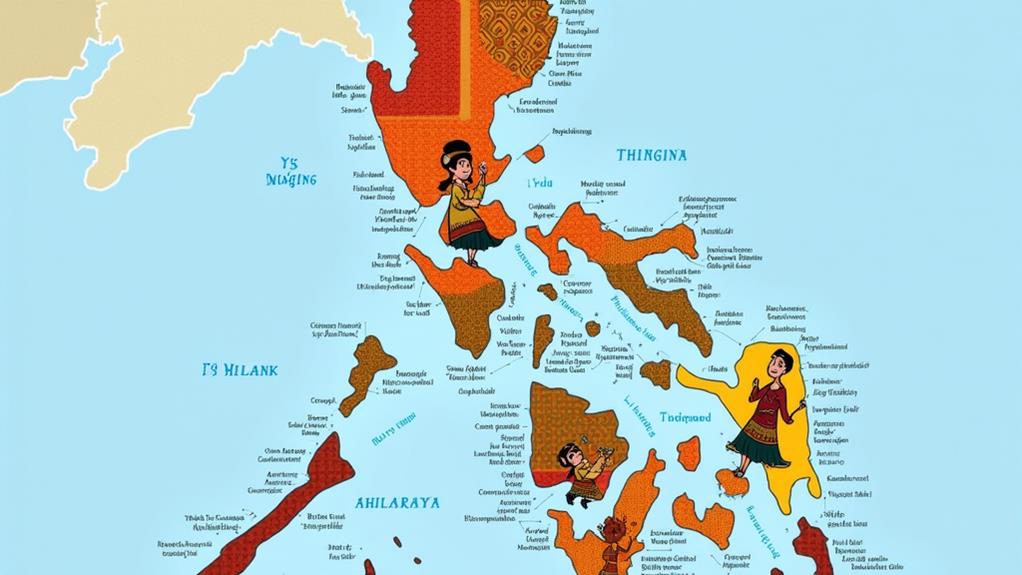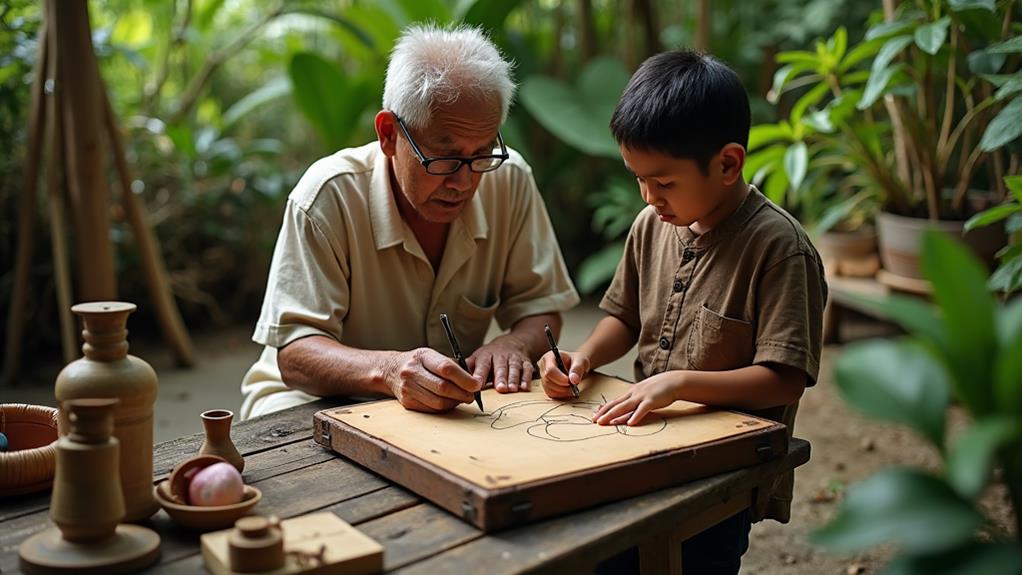Tagalog is the most widely spoken native language in the Philippines. This language has approximately 26.3 million speakers, with Filipino, based on Tagalog, serving as the national language. The widespread use of Tagalog reflects the country's linguistic identity and cultural heritage.
The Philippines has over 180 languages spoken nationwide. Among these languages, Tagalog is a lingua franca for around 31.59% of the population. As a result, Tagalog plays a significant role in shaping the national identity.
The characteristics of Tagalog are shaped by its evolution and incorporation of regional dialects.
Tagalog's variants include Manileño, Marinduqueño, and Batangas Tagalog. These regional dialects provide insight into the country's rich cultural tapestry.
Brief History of Tagalog

The National Language of the Philippines: A Brief History of Tagalog
In 1937, President Manuel L. Quezon declared Tagalog as the basis for the national language of the Philippines. This marked the beginning of Tagalog's journey to becoming the country's widely spoken language.
The language was officially renamed Pilipino in 1959, reflecting its development as a national identity. The growth of Pilipino was further supported by traditional craftsmanship initiatives, such as Traditional Weaving Revival efforts, which played a significant role in preserving the country's cultural heritage.
The government's emphasis on reviving lost arts helped to promote cultural appreciation and understanding.
The Language's Official Status
The 1972 Constitution recognized Pilipino and English as the official languages of the Philippines. However, it wasn't until 1986 that the post-EDSA Constitution affirmed Filipino, a standardized version of Tagalog, as the national language.
Tagalog Today
Today, Tagalog remains the primary language of approximately 31.59% of the Filipino population, making it the most widely spoken language in the country.
Understanding the history of Tagalog is essential to appreciating its significance in the Philippines.
Language Characteristics and Variants
Tagalog is the most widely spoken language in the Philippines, with approximately 31.59% of the population identifying it as their primary language. This widespread use is attributed to its role as a lingua franca among various ethnic groups in the central region of the Philippines.
Tagalog's language characteristics and variants have led to the development of a standardized version of the language, Filipino, which is recognized as one of the official languages alongside English. Tagalog and Filipino share a large number of common lexical items and similar grammatical structures, making them mutually intelligible.
The influence of regional languages on Tagalog can be seen in the evolution of traditional cultural heritage and the preservation of ancestral identities. For example, the use of words from other regional languages, such as Cebuano and Ilocano, has contributed to the Philippines' rich linguistic diversity.
This diversity is also reflected in the unique characteristics of Tagalog and its variants, such as distinct dialects in different regions.
Understanding the language characteristics and variants of Tagalog is essential for grasping the complexities of the Philippine language landscape. This knowledge can also provide insight into the preservation of traditional skills and techniques, such as those found in Philippine weaving traditions.
Tagalog Language Instruction

The Department of Asian Studies offers Tagalog (Filipino) language instruction at various levels. This instruction caters to diverse student needs, providing a comprehensive approach to learning the language. The levels of instruction are as follows:
| Language Instruction Level | Description |
|---|---|
| Beginning | Basic speaking, listening, reading, and writing skills are emphasized in this level. This foundational language acquisition is essential for understanding the language. |
| Intermediate | Enhancements to all four language skills and cultural understanding are incorporated into the curriculum. Students can expect to refine their language skills and gain a deeper understanding of the culture. |
| Advanced | Refining language skills and deepening cultural understanding are the main focus of this level. Students can expect to develop a more nuanced understanding of the language and its cultural context. |
| Directed Studies | Personalized learning experiences are provided in Tagalog, catering to specific student needs. This level offers flexibility and customization for students who require it.
Experienced faculty, such as Senior Lecturer M. Theresa Centeno Savella, support Tagalog language instruction. These faculty members specialize in the language and its cultural context, providing students with expert guidance and instruction. By enrolling in these courses, students can develop their speaking, listening, reading, and writing skills in Tagalog while gaining a deeper understanding of the cultural nuances that underpin the language. This comprehensive approach enables students to effectively communicate in Tagalog and navigate various social and cultural contexts.
Tagalog as a National Language
Tagalog's designation as the basis for the national language in 1937 marked a significant milestone in the Philippines' linguistic history. This decision aimed to create a unified national language, reflecting the country's linguistic diversity.
The Philippines' culturally rich metalwork heritage offers a parallel, where historical artifacts reflect the evolution of craftsmanship over centuries. The incorporation of various cultural influences, such as Spanish and indigenous elements, contribute to the unique character of the Filipino language.
As a result, Tagalog evolved into Filipino, a standardized version that serves as the official language alongside English in the Philippines. Approximately 31.59% of the Filipino population identifies Tagalog as their native language, making it the most widely spoken language in the country.
The evolution of Tagalog into Filipino accommodated various dialects, fostering national identity and communication across different regions.
The national language was renamed Pilipino in 1959, which later evolved into Filipino as recognized by the 1987 Constitution.
This transition demonstrates the country's effort to unify the nation through a common language, while embracing its rich linguistic diversity.
By adopting Filipino as a national language, the Philippines acknowledges the importance of language in shaping its national identity and promoting effective communication among its citizens.
Regional Language Variations

Filipino is a unified national language, but regional variations of Tagalog persist. The standardization of Filipino has contributed to its national recognition, but regional dialects, such as Batangas Tagalog and Laguna Tagalog, still exist, reflecting the country's linguistic diversity. These variations are influenced by local cultures and languages.
Tagalog is widely spoken in Metro Manila and surrounding provinces. The language's influence extends across various regions, with significant numbers of speakers in provinces like Quezon and Bulacan. Other regional languages, such as Cebuano and Ilocano, are also widely spoken.
Regional variations of Tagalog are an essential aspect of the language. These variations reflect the unique cultural and historical contexts of different regions.
As the national lingua franca, Filipino has played a significant role in promoting a unified language, but these regional variations highlight the importance of preserving linguistic diversity.
Filipino is spoken by approximately 31.59% of the population. By acknowledging and embracing regional variations of Tagalog, one gains a deeper understanding of the complexities and richness of the Filipino language.
Most Spoken Native Languages
The Philippines is a linguistically diverse country with numerous regional dialects.
Regional dialects of Tagalog, such as Batangas Tagalog and Laguna Tagalog, contribute to this diversity. However, a few languages dominate the linguistic landscape.
The top three native languages spoken in the Philippines are the primary drivers of this diversity.
Tagalog is the most widely spoken native language, with 26.3 million native speakers (31.59% of the population). The language is widely spoken across different regions and plays a significant role in shaping the country's identity.
Cebuano is the second most spoken native language, with over 21.3 million native speakers, representing around 25.55% of Filipinos.
Ilocano is the third most spoken native language, with more than 7.7 million speakers across the country.
These languages contribute to the country's rich cultural heritage and highlight the importance of linguistic diversity in the Philippines.
Language Preservation Efforts

The Philippines has a rich linguistic tapestry, with 180 languages spoken across the country. However, this diversity is under threat, with 28 endangered languages requiring urgent preservation efforts.
Government legislation plays a crucial role in granting more languages official status, thereby aiding in their survival and revitalization. For instance, the 1987 Philippine Constitution recognizes Filipino and English as official languages, while also promoting the use of regional languages. This recognition helps to promote the use of these languages in education, government, and media.
Documenting endangered languages is essential for maintaining cultural traditions and ensuring that the rich heritage of the Philippines is passed on to future generations. The Komisyon sa Wikang Filipino (KWF) is a government agency that documents and promotes the country's languages. The KWF works with linguists, researchers, and community members to develop language dictionaries, grammar guides, and language learning materials.
Community initiatives and educational programs also play a vital role in preserving languages. For example, the Save the Ifugao Language and Literature Program aims to preserve the Ifugao language and literature through language classes, cultural events, and language documentation. By supporting these initiatives, individuals can contribute to the preservation of Philippine languages.
Language preservation not only safeguards languages but also enhances national unity and pride among the diverse Filipino communities.
Preserving linguistic diversity is crucial for maintaining the country's cultural identity and promoting national unity. By working together, individuals can ensure the long-term survival of the Philippines' rich linguistic heritage and promote a deeper appreciation for the country's cultural traditions.
Official and National Languages
The Philippines has two official languages: Filipino and English. Both languages play critical roles in government and education.
Filipino is the national language, based on Tagalog. The Commission on the Filipino Language regulates and promotes it to unify the diverse linguistic groups in the country. Tagalog is the most widely spoken native language in the Philippines.
The historical context of the country has significantly influenced the development of Filipino and other regional languages. Colonial influences from the Spanish had a lasting impact on the development of both Filipino and other regional languages in the Philippines. The Spanish language was the official language during the colonial period.
The national language recognition of Filipino occurred in 1987, promoting unity among the diverse linguistic groups in the country. The Commission on the Filipino Language plays a crucial role in regulating and promoting the development of Filipino as a national language.
English, the other official language, continues to play a vital role in government and education, alongside Filipino.
Language Statistics and Demographics

Language statistics provide valuable insights into the linguistic landscape of the Philippines. Tagalog is the most widely spoken language in the Philippines, with approximately 31.59% of the population using it as their primary language at home, according to the 2020 Census of Population and Housing.
This percentage translates to over 26.3 million native speakers of Tagalog, making it the most spoken native language in the country.
Tagalog's significance as the national lingua franca is also reflected in its prevalence across various regions, with approximately 26.0% of the Filipino population identifying as Tagalog.
Tagalog's prominence in both urban and rural households underscores its role in the cultural landscape of the Philippines.
Understanding these demographics highlights the importance of Tagalog in the Philippines and its vital role in the country's linguistic and cultural landscape.
Government Support and Resources
Government Support and Resources
Government initiatives play a crucial role in promoting the use and development of Tagalog as the national language. Multiple government agencies support language preservation and promotion, including the Philippine Statistics Authority and other government websites that provide information on language policies and initiatives.
Key platforms, such as GOV.PH (https://www.gov.ph/) and the Open Data Portal (https://data.gov.ph/), promote transparency by making essential information and resources accessible.
Key government initiatives supporting language promotion include:
- Language policy formulation: The Senate of the Philippines and the House of Representatives formulate laws and regulations that impact language policy and support for Filipino and other regional languages. For example, the National Language Policy was enacted to promote the use of Filipino as the national language.
- Official language implementation: The Supreme Court and lower courts uphold laws and regulations that influence the recognition and use of Filipino as an official language in various government functions. For instance, Executive Order No. 335 mandates the use of Filipino in official government transactions.
- Public information dissemination: The official Gazette (https://www.officialgazette.gov.ph/) serves as a publication platform for government announcements and legal documents, ensuring the dissemination of important information to citizens.
How Does Cebuano Compare to Tagalog as a Widely Spoken Language in the Philippines?
Cebuano and Tagalog are two of the most widely spoken languages in the Philippines, each representing vibrant cultural identities. The cebuano language spoken in the visayas region is a dominant regional tongue, reflecting the heritage of the central islands, while Tagalog, as the basis of Filipino, serves as the national lingua franca.
Language in Filipino Culture

Cultural narratives in the Philippines are deeply intertwined with the country's diverse linguistic landscape. The country has over 180 languages, with Tagalog being the most widely spoken. Tagalog plays a vital part in shaping the country's identity, and the Filipino language, a standardized version of Tagalog, serves as a unifying force among diverse ethnic groups.
Tagalog is used as the medium for various forms of Filipino literature, music, and film. For example, the famous Filipino poet, Francisco Balagtas, wrote his renowned epic poem, "Florante at Laura," in Tagalog. Additionally, many popular Filipino movies and TV shows are also produced in Tagalog, reflecting the rich cultural narratives of the country.
In Filipino culture, communication is highly valued, and language instruction is crucial in preserving and promoting cultural heritage. The Department of Education in the Philippines recognizes the importance of language instruction and includes Filipino language and literature in its curriculum.
Furthermore, the recognition of Filipino Sign Language as the official sign language emphasizes inclusivity in communication, highlighting the cultural significance of the Deaf community within Filipino society.
Language is a core component that weaves together the diverse threads of the country's identity. It ensures that the cultural narratives of the Philippines continue to thrive and evolve over time.
Questions and Answers
Is Tagalog the Most Spoken Language in the Philippines?
You'll find that Tagalog is indeed the most spoken language in the Philippines, with over 26 million native speakers.
As you explore its dialects, you'll notice the language's evolution and cultural significance, particularly in its literature and education systems.
The Philippines' linguistic diversity is reflected in Tagalog's regional variations, shaped by historical influences.
Efforts to preserve the language are crucial, given its importance in the country's cultural identity and communication.
Do Filipinos Speak More English or Tagalog?
Filipinos' language usage varies greatly depending on the situation.
Filipinos tend to use more Filipino in informal settings, but English in formal or professional contexts. For example, in urban areas and education, many Filipinos have high English proficiency, often using it in formal situations such as business meetings, school classes, or official government documents.
In contrast, they may use Filipino or regional dialects at home, with friends, or in local markets, reflecting the country's cultural heritage and historical linguistics.
This bilingual nature showcases the complex dynamics of language influence on Filipino identity.
Why Was Tagalog Changed to Filipino?
The name 'Tagalog' was changed to 'Filipino' to reflect the Philippines' linguistic diversity and promote national identity. This change was a deliberate attempt at language standardization, taking into account the country's historical and cultural influences.
The shift aimed to create a unifying medium that acknowledges the nation's diverse languages and dialects. In the Philippines, there are over 180 languages spoken, with regional languages such as Ilocano, Cebuano, and Hiligaynon being widely used.
To create a more inclusive national language, Filipino incorporates elements from these regional languages. For example, the Filipino language has adopted words and phrases from other languages, such as "salamat" (thank you) from Sanskrit and "kamayan" (eating with hands) from the Kapampangan language.
What Percent of Filipinos Speak Tagalog?
Approximately 31.59% of Filipinos speak Tagalog as their first language. This percentage highlights the significance of Tagalog in the Philippines, where it serves as the basis for the national language, Filipino. Tagalog's widespread use is attributed to its adoption as a lingua franca, facilitating communication among people from different regions.
In terms of language education, Tagalog grammar plays a crucial role. Although regional variations influence the dialects, understanding the grammatical structure is essential for effective communication. For instance, the verb conjugation in Tagalog is relatively simple, with a focus on verb affixes that indicate tense, aspect, and mood.
The historical roots of Tagalog literature also contribute to its widespread adoption. The language has a rich literary tradition, with works dating back to the 17th century. The writings of prominent authors, such as Francisco Balagtas, have helped shape the language and its cultural significance.